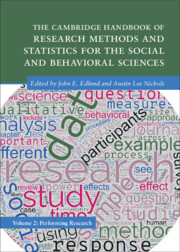 The Cambridge Handbook of Research Methods and Statistics for the Social and Behavioral Sciences
The Cambridge Handbook of Research Methods and Statistics for the Social and Behavioral Sciences from Part V - Physiological Measures
Published online by Cambridge University Press: 12 December 2024
Electroencephalography (EEG) and its measures, such as event-related brain potentials (ERPs) and time-frequency analysis (TFA), are powerful tools for investigating cognitive and behavioral processes in humans and therefore are increasingly attracting attention in the social and behavioral sciences. This chapter has been written for readers who are interested in getting involved in EEG research or who may already have some experience and wish to expand their toolbox of EEG methods. It aims to address both needs by providing a brief overview of human electrophysiology, with new users in mind, followed by a discussion of common challenges and typical applications. We conclude by describing current trends and potential for future developments.
To save this book to your Kindle, first ensure [email protected] is added to your Approved Personal Document E-mail List under your Personal Document Settings on the Manage Your Content and Devices page of your Amazon account. Then enter the ‘name’ part of your Kindle email address below. Find out more about saving to your Kindle.
Note you can select to save to either the @free.kindle.com or @kindle.com variations. ‘@free.kindle.com’ emails are free but can only be saved to your device when it is connected to wi-fi. ‘@kindle.com’ emails can be delivered even when you are not connected to wi-fi, but note that service fees apply.
Find out more about the Kindle Personal Document Service.
To save content items to your account, please confirm that you agree to abide by our usage policies. If this is the first time you use this feature, you will be asked to authorise Cambridge Core to connect with your account. Find out more about saving content to Dropbox.
To save content items to your account, please confirm that you agree to abide by our usage policies. If this is the first time you use this feature, you will be asked to authorise Cambridge Core to connect with your account. Find out more about saving content to Google Drive.